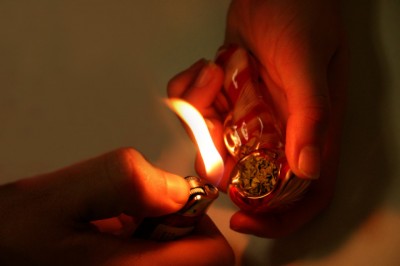Sam Freeman ’11 and Stevie Klein ’12
Web A&E Editor and Web Features Editor

Thirty years ago, students could often be seen sneaking out of school during their free periods and ducking outside the cafeteria for a quick smoke. Today, the next generation of students has extinguished its cigarettes to make way for a new substance of choice: marijuana.
Smoking pot has become something of a normal high school activity these days, according to many students at Staples.
Those same students said smoking cigarettes has become less popular than smoking pot.
“[Smoking pot] is a regular out–of–school activity for most people,” Erin Cullen ’12 said.
An Inklings poll of 114 random Staples’ students showed that 50 percent said they have tried pot, while only 31 percent have tried cigarettes. If pot is increasingly dominating the social scene, as the poll suggests, it may be because of its use as a social activity, teachers and students said.
“It’s a socially learned behavior,” said Student Outreach Counselor Chris Lemone, “kids think of weed as having fun with their friends.”
While smoking cigarettes usually occurs alone, the use of marijuana is extremely common at parties or other social gatherings. As Morgan Goldberg ’11 said, kids think “pot is just a way to have fun on the weekends.”
Students said pot is present at nearly every party—usually teens smoke outside, maybe near a garage or outside a basement door.
A bigger party might mean a larger group of students smoking, but usually it’s a relatively small group. Sometimes groups of friends plan to hang out after school and “blaze.”
“A lot of people [smoke pot]. When you’re with them, the way they act makes it seem like they’re having fun, and you want to feel like that too,” said a sophomore girl who was granted anonymity due to the illegality of her actions.
In addition to marijuana’s social use, many students smoke because they believe the health risks attached are minimal and significantly less than those commonly attached with cigarettes.
“I am not aware of risks behind pot because they do not exist,” said a junior boy.
However, numerous health risks do exist.
According to the National Institute on Drug Abuse, marijuana smoke contains 50–70 percent more cancer–causing hydrocarbons than are present in tobacco smoke.
In addition, because marijuana increases heart rate, it increases the chance of heart disease or a heart attack.
Finally, according to the National Institute on Drug Abuse, today’s marijuana can be nearly five times more powerful and dangerous than what was smoked in the 1970s. This can lead to higher addiction rates.
As marijuana usage has escalated in the past few years, the use of cigarettes has plummeted. Most pot smokers, when asked if they also smoked cigarettes, responded, “Ew, no.”
For a variety of reasons, many students now see cigarettes as unappealing.
“They just smell bad and make the smoker smell, too,” said one junior girl.
Principal John Dodig agreed. “Your clothes, skin, and hair smells of stale smoke. Your fingers turn yellow as well as your teeth,”
Starting about 20 years ago, Dodig said, cigarette smoking became much less socially acceptable.
“I have not seen an ashtray in a home in years,” Dodig said.
Another reason cigarettes are being left in the ashtray is because of the media’s messages.
Health professionals, for example, have used the media to convey the familiar message that smoking causes death.
“By smoking cigarettes you are paying to die,” said a sophomore boy. All of the media messages are against them, because they’re legal; none are about marijuana. And then there’s second-hand smoke to worry about too.
“There is so much [expletive] on the TV and in the papers about how bad smoking cigs are for you, and how bad second hand smoking is. So, if people aren’t smokers, they’re going to hate when someone smokes around them,” another junior girl said about cigarettes.
Pop culture, not just public service announcements, gives cigarettes an extremely negative connotation, Adam Bangser ’10 said.
Popular movies such as “Superbad,” “Pineapple Express,” and “Knocked Up” portray marijuana as funny and harmless and connect it to having a good time.
By contrast, popular movies of the past reflected the social scene of that time, so cigarettes were commonly featured.
In the mid-80’s, for instance, both pot and cigarette smoking were popular, so “The Breakfast Club” included both.
“So many people nationwide smoke weed and it has begun to gain so much widespread support, so filmmakers use that and it appeals to a lot of kids,” Luke Howe ’11 said.
Overall, students and experts agreed that the growth of smoking marijuana stems from the desire to conform, to be a part of the culture’s social life.
“People, especially in a town like Westport, might think you’re cool or just chill. There’s always the want to “fit in” in this town, so many people think that way and smoke pot,” said a junior girl.
How long this trend will last no one can guess, but students and others don’t see it ending soon.
“I believe immense pot smoking will continue cause it’s the cool thing to do just like smoking [cigarettes] was back in the day,” said Dylan Meissner ’11.












































